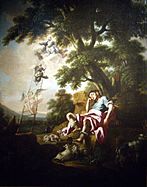Francesco Solimena facts for kids
Quick facts for kids
Francesco Solimena
|
|
|---|---|

Self-portrait, 1730
|
|
| Born | 4 October 1657 Canale di Serino, province Avellino
|
| Died | 3 April 1747 (aged 89) |
| Nationality | Italian |
| Education | Francesco di Maria |
| Known for | Painting |
| Movement | Baroque |
| Patron(s) | Pope Benedict XIII |
Francesco Solimena (born October 4, 1657 – died April 3, 1747) was a very famous Italian painter from the Baroque period. He came from a family of artists and drew and painted many artworks.
About Francesco Solimena
Francesco Solimena was born in a place called Canale di Serino. This town is in the Avellino area of Italy.
He learned to paint from his father, Angelo Solimena. Together, they painted a large artwork called Paradise for a cathedral in Nocera. They also created Vision of St. Cyril of Alexandria for a church in Solofra.
In 1674, Francesco moved to Naples. There, he worked in the art studio of Francesco di Maria. A very important person, Cardinal Vincenzo Orsini, helped him early on. This cardinal later became Pope Benedict XIII.
By the 1680s, Francesco started getting his own big painting jobs. His busy art studio became very important in Naples. It was a leading place for painting from the 1690s until the 1740s.
His Painting Style
Francesco Solimena learned from famous Roman Baroque artists. These included Luca Giordano, Giovanni Lanfranco, and Mattia Preti. He copied their way of using warm, brownish shadows in his paintings.
Solimena painted many different things. He created large wall paintings called frescoes in Naples. He also painted altarpieces for churches. He made art to celebrate weddings and royal events.
He often chose stories from myths for his paintings. These stories were picked because they had a lot of drama. He also painted many portraits of people.
In his art, he used simple backgrounds like steps, arches, or columns. This helped people focus on the figures and their clothes. He used light and shadows to make parts of his paintings stand out.
Art experts enjoy finding out which artists Solimena copied or got ideas from. He made many drawings before painting. He often used different materials like pen, ink, chalk, and watercolors for these drawings.
One example of his early work is Allegory of Rule (1690). This painting shows how well he used light and dark, a technique called chiaroscuro. This artwork is now in the State Hermitage Museum in Russia.
Francesco Solimena became very rich and lived a fancy life because of his success. He passed away in 1747 in Barra, near Naples. He was 89 years old.
Francesco wanted his nephew, Orazio Solimena, to follow in his footsteps. Orazio became his student and took over as a painter.
His Art School
Francesco Solimena's large and well-run art studio was like a school. It was a key part of the art world in Naples. Many students learned from him.
Some of his famous students were Corrado Giaquinto, Francesco De Mura, and Sebastiano Conca. A Scottish portrait painter named Allan Ramsay also studied in Solimena's studio for three years.
- Francesco Solimena
See also
 In Spanish: Francesco Solimena para niños
In Spanish: Francesco Solimena para niños











